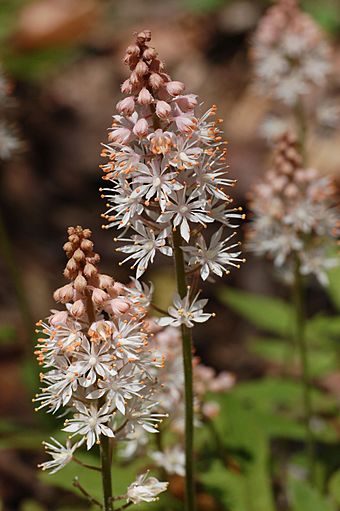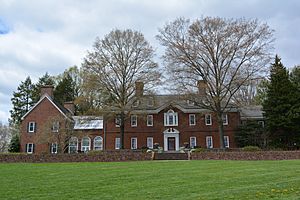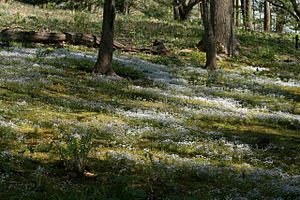Mt. Cuba Center facts for kids
Quick facts for kids |
|
|
Mt. Cuba Center
|
|

The flowers of the Foamflower (Tiarella). Photo taken at the Mt. Cuba Center where it was identified
|
|
| Location | 3120 Barley Mill Rd. |
|---|---|
| Nearest city | Hockessin, Delaware |
| Area | 7.4 acres (3.0 ha) |
| Built | 1937 |
| Built by | J. S. Cornell & Son |
| Architect | Victorine & Samuel Homsey (house) Thomas Warren Sears (landscape) |
| Architectural style | Colonial Revival |
| NRHP reference No. | 03000172 |
| Added to NRHP | April 2, 2003 |
Mt. Cuba Center is a special place in Hockessin, Delaware. It's a non-profit botanical garden, which means it's a big garden dedicated to studying and showing plants. This beautiful garden is located in the rolling hills of the Delaware Piedmont.
Its amazing woodland gardens are famous for their stunning displays of wildflowers. You can see these flowers in the mid-Atlantic region. Mt. Cuba Center welcomes visitors from April to November. They offer general admission, guided tours, and fun special programs. If you want to learn more, they also have education courses all year round. These include a special Certificate in Ecological Gardening.
Contents
Exploring the Gardens and Plants
Mt. Cuba Center is home to a huge collection of plants. They focus on studying plants that grow naturally in eastern North America. They pay special attention to plants from the Appalachian Piedmont area.
What Plants Grow Here?
The center has over 6,500 different types of plants. These plants are carefully documented and studied. The garden's plant experts do research on specific plant groups. These include Coreopsis, Heuchera, Baptisia, and Trillium. Mt. Cuba Center is also a "national collection" holder for Hexastylis and Trillium. This means they have a very important and complete collection of these plants.
Some of the plants they have introduced are very popular. These include Aster laevis 'Bluebird' and Aster novae-angliae 'Purple Dome'. Another popular one is Solidago sphacelata 'Golden Fleece'.
Different Garden Areas to Discover
The center has many different kinds of garden areas. You can find a beautiful Lilac Alleé, which is a path lined with lilac bushes. There's also a Formal Garden and a South Terrace.
But many areas are more natural. These include the Dogwood Path, a wide Meadow, and a peaceful Pond Garden. You can also walk along the West Slope Path, the Woods Path, and see the Rock Wall.
Natural Lands and Conservation
Beyond the main gardens, Mt. Cuba Center has over 500 acres of Natural Lands. These lands have steep hills, stream valleys, and forests with many trees. Mt. Cuba Center works hard to restore and protect these natural areas. They offer educational programs and do science-based research projects here.
In 2020, people voted Mt. Cuba Center the best botanical garden in the United States!
Learning and Education Programs
Mt. Cuba Center offers many classes for people who want to learn more. These classes cover topics like gardening, protecting nature, art, and wellness.
Ecological Gardening Certificate
Students can work towards a certificate in ecological gardening. This program teaches you how important gardening is for the whole natural world. It helps you understand how plants fit into a larger ecosystem.
Internships and Fellowships
The center also has a 12-week summer internship program. This is a great chance for students to get hands-on experience. They also offer a fellowship. This program supports people doing field research about plants and nature.
A Look at Mt. Cuba Center's History
Mt. Cuba Center was once the home of Lammot du Pont Copeland and his wife, Pamela Cunningham Copeland. They built their large Colonial Revival style house in 1935. It was near a small village called Mt. Cuba in Delaware.
The Copeland Family's Vision
The Copelands were important people in their community. Mr. Copeland was the President of the DuPont Company. Mrs. Copeland was a leader in many local groups. In the late 1930s, famous landscape architects helped design the formal gardens. These designers included Thomas W. Sears and Marian Cruger Coffin.
In the 1960s, the Copelands became very interested in protecting nature. Mrs. Copeland was especially worried about wildflowers. She saw how building new things was harming them. So, they hired a landscape architect named Seth Kelsey. He helped them create the beautiful woodland wildflower gardens. He also designed their ponds and many paths through the woods.
Becoming a Public Garden
In 1983, Dr. Richard Lighty became the first Director of Horticulture. The Copelands started to study native plants from the Appalachian Piedmont. This was the beginning of the botanical garden we know today. That same year, Mr. Copeland passed away.
In the late 1980s, Mt. Cuba Center started letting visitors come. They offered tours led by guides in the spring. The plant experts at Mt. Cuba Center also began writing down details about their growing collection of native plants.
Mrs. Copeland died in 2001. After that, Mt. Cuba Center became a public garden for everyone to enjoy. It was added to the National Register of Historic Places in 2003. This means it's an important historical site.
Classes for continuing education began in 2006. In 2013, Mt. Cuba Center started offering general admission. Now, people can visit the gardens during the spring, summer, and fall seasons.
See also
 In Spanish: Mt. Cuba Center para niños
In Spanish: Mt. Cuba Center para niños





